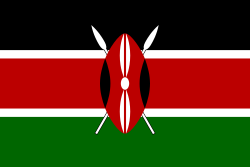Portal:Kenya

Introduction  Kenya, officially the Republic of Kenya, is a country in East Africa. With an estimated population of more than 52.4 million as of mid-2024, Kenya is the 27th-most-populous country in the world and 7th most populous in Africa. Kenya's capital and largest city is Nairobi, while its oldest and second-largest city, is the major port city of Mombasa, situated on Mombasa Island in the Indian Ocean and the surrounding mainland. Mombasa was the capital of the British East Africa Protectorate, which included most of what is now Kenya and southwestern Somalia, from 1889 to 1907. Other important cities include Kisumu and Nakuru. Kenya is bordered by South Sudan to the northwest, Ethiopia to the north, Somalia to the east, Uganda to the west, Tanzania to the south, and the Indian Ocean to the southeast. Kenya's geography, climate and population vary widely, ranging from cold snow-capped mountaintops (Batian, Nelion and Point Lenana on Mount Kenya) with vast surrounding forests, wildlife and fertile agricultural regions to temperate climates in western and rift valley counties and further on to dry less fertile arid and semi-arid areas and absolute deserts (Chalbi Desert and Nyiri Desert). Kenya's earliest inhabitants were hunter-gatherers, like the present-day Hadza people. According to archaeological dating of associated artifacts and skeletal material, Cushitic speakers first settled in Kenya's lowlands between 3,200 and 1,300 BC, a phase known as the Lowland Savanna Pastoral Neolithic. Nilotic-speaking pastoralists (ancestral to Kenya's Nilotic speakers) began migrating from present-day South Sudan into Kenya around 500 BC. Bantu people settled at the coast and the interior between 250 BC and 500 AD. European contact began in 1500 AD with the Portuguese Empire, and effective colonisation of Kenya began in the 19th century during the European exploration of Africa. Modern-day Kenya emerged from a protectorate established by the British Empire in 1895 and the subsequent Kenya Colony, which began in 1920. Numerous disputes between the UK and the colony led to the Mau Mau revolution, which began in 1952, and the declaration of independence in 1963. After independence, Kenya remained a member of the Commonwealth of Nations. The current constitution was adopted in 2010 and replaced the 1963 independence constitution. (Full article...)
Selected article - The East African Railway Master Plan is a proposal for rejuvenating the railways serving Tanzania, Kenya, and Uganda, and building new railways to serve Rwanda and Burundi. The objective is to further the economic development of East Africa by increasing the efficiency and speed, and lowering the cost, of transporting cargo between major ports on the Indian Ocean coast and the interior. A later step would expand the East African railway network to South Sudan, Ethiopia, and the Democratic Republic of the Congo (DR Congo). The plan is managed by infrastructure ministers from participating East African Community countries in association with transport consultation firm CPCS Transcom Limited. (Full article...) Selected picture - Airborne in Masai Mara, Narok County.
Selected location -Nakuru County is a county in Kenya. The capital and largest town is Nakuru, although Naivasha is another major significant urban centre. With a population of 1,603,325 (2009 census), it is the fourth largest county in Kenya after Nairobi, Kakamega and Kiambu in that order in terms of population. Nakuru County has an area of 2,325.8 km². Nakuru is an agriculturally-oriented area and is home to Lake Nakuru and Lake Naivasha some of the Rift Valley soda lakes. Lake Nakuru is best known for its thousands, sometimes millions of flamingoes nesting along the shores. The surface of the shallow lake is often hardly recognisable due to the continually shifting mass of pink. The number of flamingoes on the lake varies with water and food conditions and the best vantage point is from Baboon cliff. Also of interest, an area of 188 km around the lake fenced off as a sanctuary to protect Rothschild giraffe and black rhinos. Other sites of interest around Nakuru include Menengai Crater, an extinct volcano 2,490m (8,167 ft) high. The views of the crater itself, as well as the surrounding countryside, are spectacular. (Read more...) This is a Good article, an article that meets a core set of high editorial standards.
Kenya sent a delegation to compete at the 2006 Winter Olympics in Turin, Italy, from 10–26 February 2006. This was Kenya's third time participating in a Winter Olympic Games. The Kenyan delegation consisted of one athlete, cross-country skier and three-time Olympian Philip Boit. In his only event, he finished 91st in the men's 15 kilometre classical. (Full article...) Selected biography - Bethwell Allan Ogot (3 August 1929 – 30 January 2025) was a Kenyan historian and academic who specialised in African history, research methods, and theory. One of his works started by saying that "to tell the story of a past so as to portray an inevitable destiny is, for humankind, a need as universal as tool-making. To that extent, we may say that a human being is, by nature, historicus". Ogot was the Chancellor of Moi University up to early 2013. (Full article...) Related portalsDid you know (auto-generated) -
In the news
Wikinews Kenya portal
Selected panorama -Panorama of Mount Kenya around Shipton's Camp
General images -The following are images from various Kenya-related articles on Wikipedia.
Topics in KenyaCategoriesAssociated WikimediaThe following Wikimedia Foundation sister projects provide more on this subject:
Discover Wikipedia using portals |










































